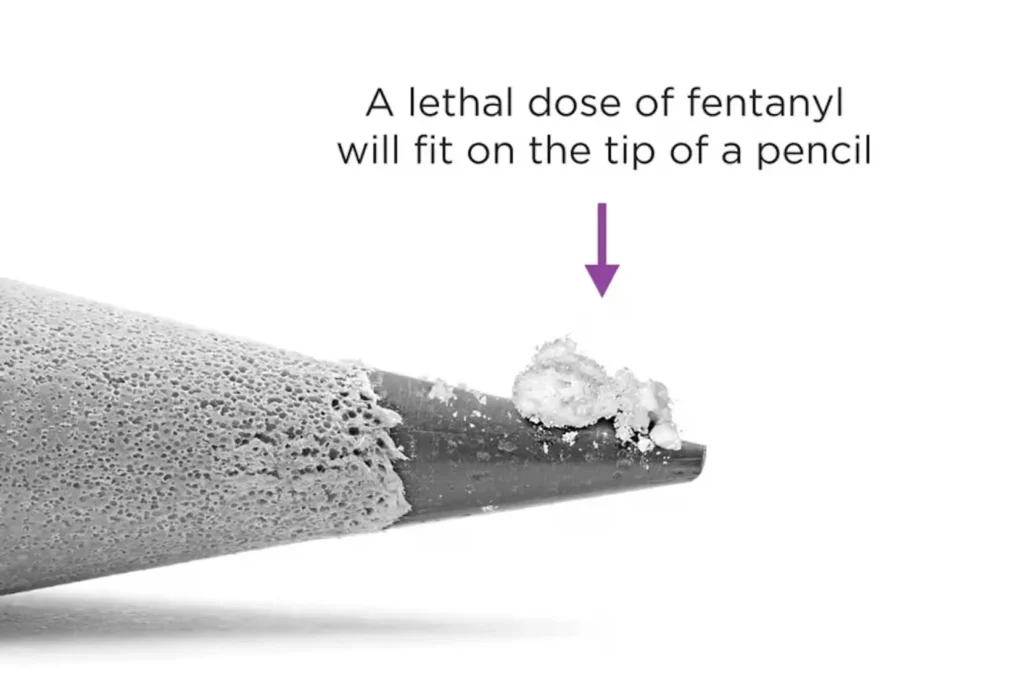Cornerstone
Fentanyl
Overview
Information about Fentanyl, identifying signs of addiction, and recovery.
Understanding Fentanyl as a Drug
Fentanyl is a powerful synthetic opioid that was first developed in 1959 by Paul Janssen, a Belgian chemist. It was initially used as an intravenous anesthetic and pain reliever for patients undergoing surgery or experiencing severe pain. Fentanyl is 50 to 100 times more potent than morphine and is classified as a Schedule II controlled substance due to its high potential for abuse and addiction.
In recent years, illicitly manufactured fentanyl has become a significant contributor to the opioid epidemic, often mixed with other drugs or pressed into counterfeit pills, leading to an increased risk of overdose and death. Fentanyl’s potency and rapid onset of action make it highly addictive, and the consequences of fentanyl addiction can be devastating, impacting individuals, families, and communities. The widespread availability of illicit fentanyl has contributed to a surge in opioid-related deaths, making it a pressing public health concern that requires urgent attention and comprehensive solutions.1
Jump to the following sections
View our Arizona treatment locations
Understanding Fentanyl
Fentanyl is a synthetic opioid that was first developed by Paul Janssen, a Belgian chemist, in 1959. It was initially synthesized as an intravenous anesthetic and pain reliever for patients undergoing surgery or experiencing severe pain, such as cancer patients. Fentanyl is a member of the phenylpiperidine class of opioids and is structurally similar to other opioids like meperidine and sufentanil. Due to its high potency and potential for abuse, fentanyl is classified as a Schedule II controlled substance in the United States.2
Pharmaceutical fentanyl is available in various forms, including transdermal patches, lozenges, films, and injectable solutions. Illicitly manufactured fentanyl, which has become a significant contributor to the opioid epidemic, is often found as a white or off-white powder. It can also be pressed into counterfeit prescription pills or mixed with other drugs, such as heroin or cocaine, making it difficult to identify by appearance alone.3
Fentanyl, in its pure form, is odorless. However, illicitly manufactured fentanyl may have a slightly sweet or medicinal scent due to the chemicals used in its production. When mixed with other substances, such as heroin or cocaine, the smell of fentanyl may be masked by the odor of the other drugs. The scent of fentanyl in pill form, when smoked, smells like popcorn, and the powder form has a sweeter scent to it.
Fentanyl can be ingested in several ways, depending on the form of the drug. Pharmaceutical fentanyl can be administered through transdermal patches, lozenges, films, or injectable solutions. Illicitly manufactured fentanyl is often snorted, smoked, or injected. In some cases, fentanyl may be unknowingly ingested when it is mixed with other drugs or pressed into counterfeit prescription pills.
Fentanyl use is often associated with specific types of paraphernalia that can help identify its abuse. Typical items include small, folded pieces of foil or foil strips used for smoking the drug, as well as glass pipes and straws for inhalation. Users might also have syringes for injecting fentanyl, along with spoons or bottle caps that have burn marks, indicating they have been used to dissolve the drug for injection. Additionally, small plastic bags or containers, often with powdery residue, and prescription bottles without labels can be signs of fentanyl possession. Recognizing these items can be crucial for identifying and addressing fentanyl abuse.
Identifying Fentanyl
Identifying fentanyl can be challenging, as it is often mixed with other substances or disguised as counterfeit prescription pills.
Fentanyl, in its pure form, is a white or off-white powder, but the color and consistency may vary when it is cut with other substances. Illicitly manufactured fentanyl may be indistinguishable from other drugs like heroin or cocaine, making it difficult for users to know if they are consuming fentanyl.
In some cases, fentanyl may be pressed into pills that closely resemble legitimate prescription opioids, such as oxycodone or hydrocodone. The only definitive way to identify fentanyl is through laboratory testing, which can detect the presence of the drug and its analogs.
Facts About Fentanyl
Fentanyl Overdose
Fentanyl overdose is a serious and life-threatening condition that occurs when an individual consumes a toxic amount of the drug. Due to fentanyl’s high potency, even small amounts can lead to overdose, especially when mixed with other substances. Symptoms of fentanyl overdose include pinpoint pupils, shallow or absent breathing, loss of consciousness, and blue lips or fingernails. Naloxone, an opioid antagonist, can quickly reverse the effects of an overdose if administered promptly.4
Fentanyl and the Opioid Epidemic
The widespread availability of illicitly manufactured fentanyl has significantly contributed to the ongoing opioid epidemic. Fentanyl’s high potency and low production costs have made it an attractive option for drug dealers, who often mix it with other substances to increase profits. The presence of fentanyl in the illicit drug supply has led to a surge in opioid-related overdoses and deaths, making it a pressing public health concern.
Fentanyl Addiction Treatment
Treatment for fentanyl addiction typically involves a combination of Medication-Assisted Treatment (MAT), behavioral therapies, and support services. MAT consists of the use of medications, such as Buprenorphine or Methadone, to reduce cravings and withdrawal symptoms while promoting long-term recovery. Behavioral therapies, such as Cognitive Behavioral Therapy and contingency management, help individuals modify their drug use patterns, develop coping skills, and address co-occurring mental health issues.
Fentanyl and Harm Reduction
Fentanyl and Counterfeit Prescription Pills
The rise of illicitly manufactured fentanyl has led to an alarming increase in counterfeit prescription pills containing the drug. These pills often resemble legitimate medications like oxycodone or hydrocodone but can contain lethal doses of fentanyl. Many individuals consuming these pills are unaware of their actual content, putting them at high risk of overdose and death. This prevalence has made it difficult for users to know the potency and composition of the substances, worsening the opioid crisis.
Fentanyl and Naloxone Access
Naloxone, an opioid antagonist, is crucial in preventing fentanyl-related overdose deaths by quickly reversing the effects and restoring breathing. Increasing access to naloxone is key in combating the fentanyl crisis, as timely administration can save lives. Many states have expanded access by allowing pharmacists to dispense it without a prescription and equipping first responders with the drug. At the same time, community organizations and harm reduction groups distribute naloxone to those at high risk of overdose.
Recovering From Fentanyl Addiction
Overcoming fentanyl addiction is a challenging but achievable goal with the proper support, treatment, and dedication. The path to recovery often involves a combination of medication-assisted treatment, behavioral therapies, and support from family, friends, and peers. MAT, which includes medications like Buprenorphine or Methadone, can help manage withdrawal symptoms, reduce cravings, and promote long-term recovery. Behavioral therapies, such as Cognitive-Behavioral Therapy and contingency management, help individuals develop coping skills, address underlying mental health issues, and modify their drug use patterns. Engaging with support groups, such as Narcotics Anonymous or SMART Recovery, can provide a sense of community and accountability throughout the recovery process. It is important to recognize that recovery is a lifelong journey, and relapse is common. However, with perseverance, self-compassion, and a strong support system, individuals can overcome fentanyl addiction and build a fulfilling life in recovery.
The Stages of Fentanyl Addiction
Fentanyl addiction often begins with initial use, either through prescription misuse or illicit sources, driven by a desire for pain relief or a euphoric high. Individuals require higher doses to achieve the same effect as tolerance develops, leading to increased use.
Dependency sets in, marked by intense cravings and withdrawal symptoms such as severe pain, nausea, and anxiety when not using the drug. Over time, compulsive use and loss of control over consumption characterize full-blown addiction despite the negative impact on health, relationships, and daily functioning.
This cycle perpetuates, making breaking free without professional intervention and support increasingly difficult.
FAQs About Fentanyl
What Is Fentanyl and Why Is It So Dangerous?
Fentanyl is a synthetic opioid analgesic that is significantly more potent than morphine and is often used medically for severe pain management.
Its high potency, about 50 to 100 times stronger than morphine, makes it effective in controlled medical settings but extremely dangerous when misused.
Even a tiny amount can cause a fatal overdose by rapidly depressing respiratory function, leading to respiratory failure.
Fentanyl’s potency and rapid onset increase the risk of accidental overdose, especially when mixed with other substances or consumed unknowingly in counterfeit pills.
This lethality makes fentanyl a significant contributor to the current opioid overdose crisis.
What Are the Signs of Fentanyl Addiction?
Recognizing the signs of fentanyl addiction can help in seeking timely intervention and treatment.
Here are some common indicators:
- Increased Tolerance: Higher doses are needed to achieve the same effects.
- Cravings: Intense desire or urge to use fentanyl.
- Neglecting Responsibilities: Ignoring work, school, or family obligations.
- Financial Problems: Spending excessive money on fentanyl leads to financial instability.
- Changes in Social Behavior: Isolating from friends and family or associating with a new group involved with drug use.
- Risky Behaviors: Engaging in dangerous activities to obtain or use fentanyl.
- Physical Symptoms: Drowsiness, pinpoint pupils, weight loss, and frequent flu-like symptoms.
- Psychological Symptoms: Anxiety, depression, mood swings, and irritability.
- Withdrawal Symptoms: Nausea, sweating, shaking, and agitation when not using fentanyl.
- Failed Attempts to Quit: Inability to stop using fentanyl despite wanting to quit.
- Secretive Behavior: Hiding drug use or lying about the frequency and amount of use.
- Paraphernalia: Presence of items like syringes, burnt spoons, or small plastic bags.
What Are the Signs of a Fentanyl Overdose?
Recognizing the signs of a fentanyl overdose is critical for timely intervention and can save lives.
Here are some common indicators:
- Slow or Shallow Breathing: Breathing may become extremely slow, shallow, or stop entirely.
- Unresponsiveness: Inability to wake up or respond to stimuli.
- Pinpoint Pupils: Tiny, constricted pupils.
- Bluish Lips or Fingernails: Indicating a lack of oxygen.
- Weak Pulse: A weak, slow, or irregular pulse.
- Discolored Skin: Pale or clammy skin.
- Choking or Gurgling Sounds: Noisy breathing or sounds resembling choking.
- Loss of Consciousness: Falling into a deep state of unconsciousness or coma.
- Limp Body: The body may become very limp and floppy.
- Vomiting: Nausea and vomiting may occur.
If you suspect someone is experiencing a fentanyl overdose, it is critical to seek emergency medical help immediately and administer naloxone if available.
What Should I Do if I Suspect a Loved One Is Using Fentanyl?
If you suspect a loved one is using fentanyl, it’s important to approach the situation with care and support.
Start by educating yourself about fentanyl and its risks to understand better what your loved one is experiencing.
Have an open, non-judgmental conversation with them, expressing your concern for their well-being and willingness to help.
Please encourage them to seek professional help, such as contacting a healthcare provider or addiction specialist, and offer to assist in finding appropriate treatment options.
Ensure that naloxone, an opioid overdose reversal medication, is readily available and that you know how to use it in case of an emergency.
Additionally, consider contacting support groups or counseling services for yourself and your loved one to navigate this challenging situation effectively.
If you or a loved one is struggling with fentanyl addiction, please reach out to us at Cornerstone Healing Center for a free and confidential assessment.
We provide fentanyl addiction treatment services, and a lot of time, your insurance will cover it!
Sources
CLINICALLY REVIEWED

Faz Yar Khan, MD FACP
Medical Director
Dr. Faz Yar Kahn, our Medical Director, is an American Board of Internal Medicine-certified physician. He graduated from the Medical University of the Americas and completed his residency at Mercy Hospital in Chicago. With expertise in primary care, hospitalist medicine, critical care, and addiction medicine, along with ACLS certification, Dr. Kahn leads our team in providing exceptional substance abuse treatment.
- Read our Editorial Policy

Get Started
Now
Call and speak with one of our caring team members about help for you or a loved one.
Get informed
Visit Cornerstone's
Recovery Knowledge Base
How Long Does Fentanyl Stay in Your Urine?
How long does fentanyl stay in your urine? This article covers fentanyl and its metabolite detection in urine tests and...
Read MoreBreaking Free: Overcoming Fentanyl Withdrawal
This guide covers Fentanyl withdrawal, including symptoms, management strategies, and the importance of preventive measures and education.
Read MoreFentanyl Overdoses in Arizona: Teens Take Action with PSAs
This article dives into the teen-led "No Second Chance" PSA campaign, highlighting the alarming fentanyl overdoses in Arizona and the...
Read More























